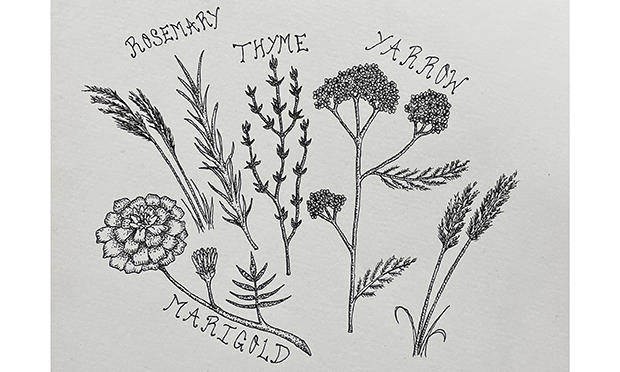The Citizen Gardener: ‘Foraging is such a lost art’

Illustration: Sacha Lacey
In my first column last month, I laid out my plans to do a little guerilla gardening at Mabley Green.
What is it I want from planting these herbs and flowers? Seasonality, resilience, beauty. A bold statement, perhaps, but let’s start small and grow things together. Let’s create a foragers’ haven that will exhume curiosity and interaction.
You don’t need to look or listen too hard in Hackney to find art and inspiration. It’s often outside. It’s pouring off the walls in Hackney Wick. It’s falling off the trees, slowly dying as each social marketer type taps away for a handsome paycheck to sustain their stay here. It’s in the low hum and the sound of a narrow boat moving down the canal, chugging along to the next respite – a fight for a spodge. It’s in the back rooms, the sound of a rolling bass. It’s the wind through the willows of the towpath, the Saturday sourdough satisfaction, the bougie offy-bought veg.
I love the beguiling impermanence of graffiti, for example, as an expression. But it’s fleeting. Annual plants and life itself is fleeting too, and you only really love something because you know it’s going to die. Plants grow, however, and there’s somewhat of a permanence to that. I want to see if I can unearth that, or try at least!
The plant-out date for Mabley Green has been pushed back a bit. I’ve expanded my plans, and that means I’m forced to wait for slightly warmer conditions. I don’t think yarrow or marigolds will love going into the ground just yet. The perennials could die off in the cold that February is sure to bring.
When the time comes, I envision a common place for people to take from and cook with – from park to plate. I’d love for people to add to it, create somewhere we can go to for herbs.
It genuinely makes me feel awful to buy a small packet of herbs from the supermarket. They have often been grown elsewhere, wrapped in plastic and shipped out to shops, where we pay over the odds for a small handful. It makes no sense.
Pomegranates, for example, are difficult to grow here. I’ve taken those off the list. In fact, they’re almost impossible to grow here. But herbs. Hardy, strong herbs. Surely we can manage those?
We’re in a time when we’re being bombarded with all sorts of information about what to eat, what’s good for us, what’s not. Eat meat, bone marrow and raw milk. No, eat vegetables and cut the carbs. Ahem, eat vegan, here’s the science. It’s enough to make your head spin.
I subscribe to a diet of seasonal and local food – as much as possible, anyway. One of the brilliant things about hardy herbs is that they live so harmoniously with other beautiful and very edible flowers. Foraging is such a lost art, for most of us at least.
I was renovating a back garden last year with a chap called Richard, who grew up on a farm. We were in south-east London, and the front garden was home to a huge fruit tree bearing a small yellow fruit. I had no idea what it was, but thought it might be a plum tree. With no hesitation, Rich stood on a low retaining wall, plucked a fruit and popped it straight in his gob. A few chews confirmed it was in fact a plum. I couldn’t believe it. He was so confident in what it was. I think we all have an intrinsic fear of eating things from the ground, a tree, or just generally from the outdoors within a city. I’m hoping that my guerilla gardening efforts will help people become more adventurous.
As a side note, I’d recommend checking out planetgoodearth.com and urban-organic.co.uk. These organisations are doing brilliant and inspiring work, with a heavy focus on edible gardens. They collaborated with Betongpark, a skate park builder, to showcase their work at last year’s Chelsea Flower Show. It featured a two-tonne granite skate ramp nestled amongst an edible garden – an amazing project, very inspiring.
Daniel Burke is a trained gardener with almost 10 years’ experience. He is a founder of a community interest company The Hackney Flower Show, which aims to renovate public spaces and create an annual community event celebrating the borough’s horticulture.
